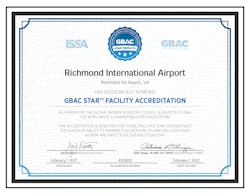Richmond International Airport Achieves GBAC STAR Facility Accreditation
Richmond International Airport (RIC) announced that it achieved Global Biorisk Advisory Council (GBAC) STAR accreditation, the gold standard for prepared facilities. Under the guidance of GBAC, a Division of ISSA, the worldwide cleaning industry association, RIC has implemented the most stringent protocols for cleaning, disinfection, and infectious disease prevention in its facilities.
“The GBAC STAR Facility accreditation program provides third-party validation of our Building Services team’s cleaning, disinfection, and infection prevention protocols and procedures,” said Perry J. Miller, A.A.E., I.A.P., president and CEO of the Capital Region Airport Commission. “While we are happy to be a leader among Virginia facilities, becoming the first and only airport in the Commonwealth to earn such accreditation was not our aim. Our single motivation for achieving this certification was to do all we could to ensure passenger safety. We want people to know that it is safe to fly out of RIC.”
As the cleaning industry’s only outbreak prevention, response, and recovery accreditation, GBAC STAR helps organizations establish protocols and procedures, offers expert-led training, and assesses a facility’s readiness for biorisk situations. The program verifies that the airport implements best practices to prepare for, respond to and recover from outbreaks and pandemics.
“GBAC STAR accreditation empowers facility owners and managers to assure workers, customers and key stakeholders that they have proven systems in place to maintain clean and healthy environments,” said GBAC Executive Director Patricia Olinger. “By taking this important step to pursue GBAC STAR, Richmond International Airport has received third-party validation that it follows strict protocols for biorisk situations, thereby demonstrating its preparedness and commitment to operating safely.”
To achieve GBAC STAR accreditation, RIC was required to demonstrate compliance with the program’s 20 core elements, which range from standard operating procedures and risk assessment strategies to personal protective equipment and emergency preparedness and response measures.
